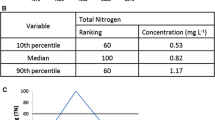Abstract
A systems analysis of the Lake Tahoe Basin indicates significant and accelerating environmental deterioration within the basin, suggests that Tahoe is poised for yet another round of urban expansion, delineates the portion of Tahoe's resources that are consumed by gaming recreation vis-à-vis outdoor recreation, and identifies the Federal government as a contributor to Tahoe's problems. In response to the need for a holistic approach to basin-wide planning and management, ecological carrying capacity concepts are explored as they may be applicable to the Basin's growth patterns, and ideas on establishing a carrying capacity for Tahoe are developed.
Similar content being viewed by others
Literature cited
California State Water Resources Control Board. 1980. Water quality plan: Lake Tahoe Basin. State of California. Sacramento, CA. 278 pp.
Costanza, R. 1980. Embodied energy and economic valuation.Science 210:1219–1224.
Costle, D. 1980. Progress and challenges.EPA Journal 6:2–6. Executive Order. 1980. Number 12240.
Holling, C. S. 1977. Future strategies for energy development. Oak Ridge Associated Universities, Oak Ridge, TN. p. 34.
Lavine, M. J., and A. H. Mayburg. 1978. Energy analysis and environmental analysis in transportation planning. Pages 859–87in R. A. Fazzolare and C. B. Smith (Eds.), Energy use management. Pergamon Press, New York, NY.
Odum, H. T. 1976. Energy quality and carrying capacity of the earth.Tropical Ecology 16:1–8.
Odum, H. T., and E. C. Odum. 1976. Energy basis for man and nature. McGraw-Hill, New York, NY. 285 pp.
Smith, R. C., J. Tyler, and C. R. Goldman. 1973. Optical properties and color of Lake Tahoe and Crater Lake.Limnology and Oceanography 18:189–199.
Tahoe Federal Coordinating Council. 1980. Reaching consensus on environmental thresholds and a carrying capacity for the Lake Tahoe Basin: A work plan. U.S. Department of Agriculture—Forest Service, South Lake Tahoe, CA. 81 pp.
Tahoe Regional Planning Agency. 1977. Water quality management plan. Tahoe Regional Planning Agency, South Lake Tahoe, CA. 71 pp.
U.S. Department of Commerce. 1979. Economic Report of the President, Table B-43, New Construction Activity, 1929–1978. Washington, DC.
Western Federal Regional Council. 1979. Lake Tahoe environmental assessment. U.S. Department of Agriculture-Forest Service, San Francisco, CA. 240 pp.
Wise, J. 1978. The Lake Tahoe study. U.S. Environmental Protection Agency. San Francisco, CA. 141 pp.
Author information
Authors and Affiliations
Rights and permissions
About this article
Cite this article
Gilliland, M.W., Clark, B.D. The Lake Tahoe Basin: A systems analysis of its characteristics and human carrying capacity. Environmental Management 5, 397–407 (1981). https://doi.org/10.1007/BF01866818
Issue Date:
DOI: https://doi.org/10.1007/BF01866818




